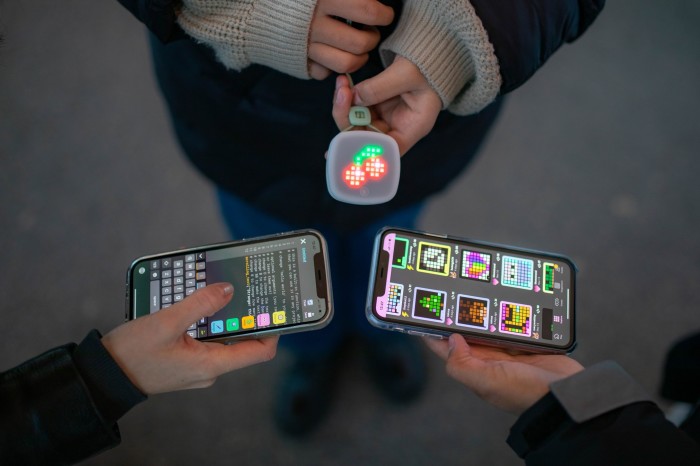Imagi sets out to get more girls into coding

Roula Khalaf, Editor of the FT, selects her favourite stories in this weekly newsletter.
Schoolgirls score as high, or higher, than boys in science and mathematics. But the older they get, the less likely they are to study technical subjects, or make careers in them.
Women are particularly absent from high-tech jobs. In the world’s 20 leading economies, they account for only a quarter of workers in data and artificial intelligence, 15 per cent of engineers, and just 12 per cent of those in cloud computing, according to the World Bank.
This gender gap in tech is not just a waste of potential talent — it is also a weakening of democracy, argues Dora Palfi, co-founder of imagi, a Swedish start-up that wants to help redress the balance.
“If we believe that tech is our future, and we know that women are not equally involved, logically it means women don’t have the same chance to shape the future,” Palfi says.
“Tech jobs are not just great careers . . . beyond that, tech has a disproportionate power to shape the world — so we need diversity among the creators if it is going to benefit everyone.”
Imagi’s contribution is an LED display encased in a chunk of silicon the size of a large key fob. Called the imagiCharm, the display can be programmed by a child via a bluetooth connection to light up in myriad colourful shapes and animations.
For parents, this is a chance to get their children off TikTok and into using their phones for something creative and social. For schools, this is a way to teach computer programming to 8-14 year olds that breaks with the standard block coding approach — where children drag and drop commands — and introduces children to Python, a widely used coding language.
“We have been coding in classrooms for a long time with visual blocks, but this is the next level,” says Laurie Guyon, a co-ordinator for educational technology programmes in New York state and a volunteer ambassador for imagi.

“The imagiCharm is teaching an actual programming language — a real skill used in many fields today — so it is building on a stronger foundation,” she says. “It offers students a chance to learn right away with Python, without using blocks.”
While the imagiCharm is not marketed as a girls’ toy, its features are designed to appeal specifically to girls, such as its ability to double as a fashion accessory. The charm can also be programmed to flash to the beat of a song.
“In schools, it is used by girls and boys, who are not aware that it is designed to be gender inclusive,” Palfi says. “We don’t want to exclude boys, and we have not. But 70 per cent of the mobile app users are girls and non-binary, which inverts the usual gender division in tech.”
At a young age, boys and girls are equally interested in computers. But, by age 14, a gap has appeared, according to research by Google and Gallup, with only one in eight girls still engaged.
New research suggests that, even in a country such as Sweden that prides itself on gender equality, strong stereotypes push girls away from tech. Both students and teachers in Swedish schools believe men are better at technology, leading to reduced interest and confidence among girls, the research at Lund University found. Teaching methods in schools were also putting girls off technology.
“Computer games are often masculine, so it is good to have variation, to try to interest everyone,” says Una Tellhed, associate professor in psychology at Lund and co-author of the research.
“We do all sorts of well-meaning interventions, [but] then we don’t evaluate them. Imagi needs to measure girls’ confidence to code before and after playing with the toy, and compared with a control group. It needs to be evaluated.”
The idea for a toy to encourage girls to code was born when Palfi and co-founder Beatrice Ionascu were studying at the Royal Institute of Technology in Stockholm. They started with a crowdfunding campaign on Kickstarter, and were helped by the institute to turn it into a business in 2018.
Since then, they have raised €1mn from angel investors, including £200,000 from Morgan Stanley. Imagi plans to break even within 18 months, focusing mainly on educational markets.
“Neither I nor Beatrice aspired to start a business, we have to credit the Swedish [start-up] ecosystem,” Palfi says. “Entrepreneurship is so core here, it made us see how we could do this.”
Sweden has long punched above its weight in terms of fast-growing tech start-ups, being home to trailblazers such as Spotify, Klarna, Mojang, Skype and iZettle. Could the country’s next unicorn — as billion-dollar start-ups are dubbed — emerge in educational technology? The sector globally is forecast to grow rapidly in the decade to come.
“The soil is fertile — we have a very well established infrastructure in Swedish schools, a high degree of technology penetration, very good internet in the home, and the domestic market is very competitive,” says Jannie Jeppesen, head of Swedish Edtech Industry, a trade association. “But we have not yet seen a company really take off.”
Technology penetration is so high that, when Covid hit, the sector did not see increased domestic sales because the necessary platforms were already in place, Jeppesen says. She is concerned, however, that a government push to reduce the use of technology in schools — including a proposed ban on screens in kindergartens — may affect Swedish edtech companies. Some are already talking about leaving the Swedish market altogether, she adds.
But imagi is already looking to the US for growth, encouraged by educators’ experience of girls actively engaging with the technology. It may encounter stiff competition: according to market intelligence company HolonIQ, the US is home to 16 edtech unicorns.
Palfi, however, has faith in her product. “This is a more creative and artistic way of learning to code,” she says. “It is able to attract an audience that traditionally has not been interested.”

Comments